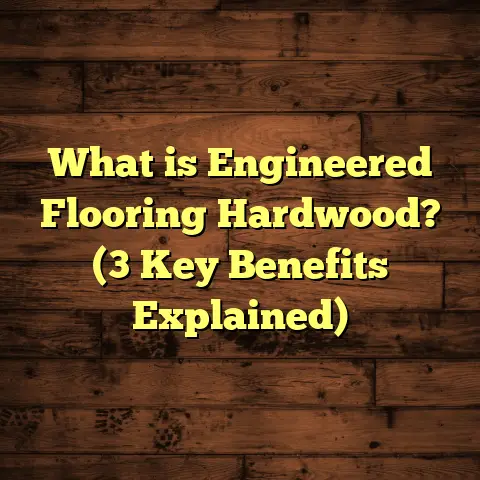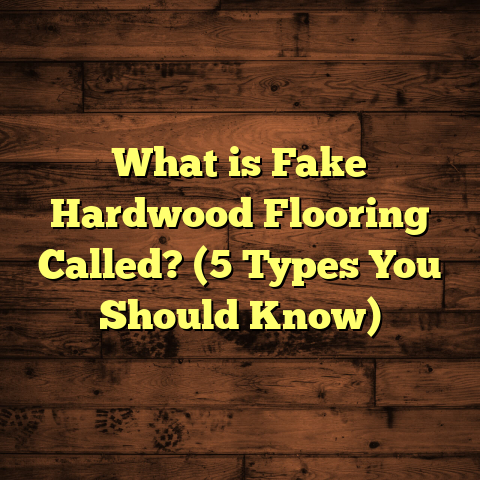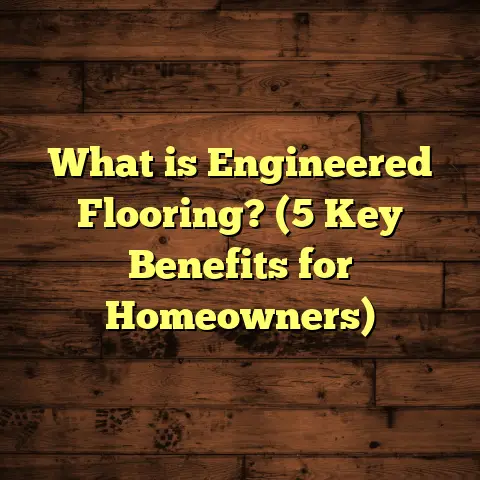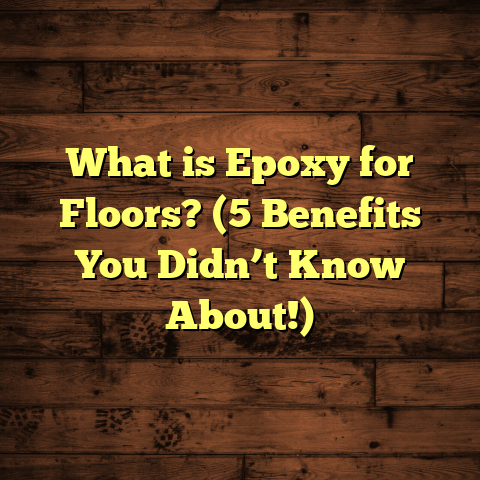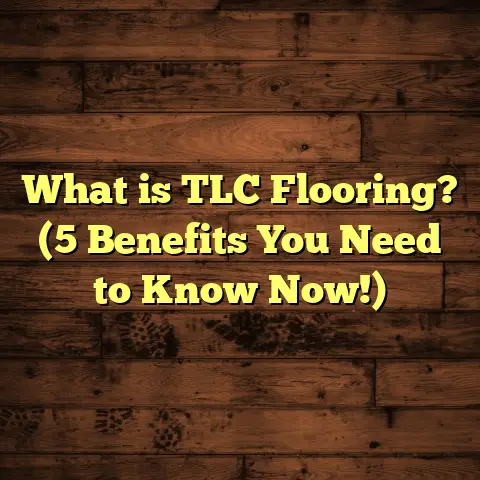What is Worth of Wood Flooring? (5 Key Factors Revealed!)
I have always admired how wood flooring balances style with ease of care. Honestly, one of the main reasons I recommend wood floors to my clients is because they are so simple to maintain. A quick sweep or vacuum every few days and a damp mop now and then keep the floors looking fresh. No special cleaners or complicated routines needed. This low-maintenance aspect makes wood flooring very appealing for busy households—whether you have kids, pets, or just don’t want to spend hours cleaning.
But beyond that, wood flooring offers much more value than surface-level beauty and convenience. Its worth stretches across multiple dimensions—durability, aesthetic appeal, resale value, and even your home’s overall atmosphere. I want to share what I’ve learned over many years working on flooring projects, helping homeowners choose the right wood floors, and maintaining them so they last a lifetime.
What Is the Worth of Wood Flooring?
I often hear people say, “Wood floors look great, but are they really worth the cost?” That’s an excellent question. When I say “worth,” I’m thinking about how much value you get from wood flooring relative to its price—not just the upfront expense but the overall benefits and savings over time.
The worth of wood flooring isn’t just about dollars per square foot. It’s a combination of:
- How it enhances your home’s beauty and comfort
- How long it lasts without needing replacement
- How much it costs to install and maintain
- How it affects your home’s resale price
- How it fits your lifestyle and personal preferences
Understanding these aspects helps you see wood floors as an investment rather than a simple purchase. And like any investment, knowing what factors affect its value can save you money and headaches down the road.
1. The Type of Wood Makes a Huge Difference
I’ve installed hundreds of wood floors over the years, and one constant remains: the type of wood you choose dramatically impacts both cost and durability.
Solid Hardwood vs. Engineered Wood
When choosing wood flooring, the first big decision is between solid hardwood and engineered wood.
- Solid Hardwood: This is made from a single piece of timber, usually ¾ inch thick. It’s heavy, feels substantial underfoot, and can be sanded and refinished multiple times—sometimes up to 10 times—depending on thickness.
- Engineered Wood: This consists of a thin top veneer of real hardwood glued over plywood or high-density fiberboard layers. It’s more dimensionally stable, meaning it resists expansion and contraction due to humidity changes better than solid wood.
I once had a client living in a coastal area with high humidity swings. They wanted traditional oak hardwood but after discussing moisture risks, we went with engineered wood for their entire home. Not only did it hold up better to moisture fluctuations, but it also saved them from costly repairs down the road.
Price Comparison:
- Solid hardwood flooring generally costs between $5 to $12 per square foot for materials alone.
- Engineered wood ranges from $4 to $10 per square foot depending on veneer thickness and wood species.
Wood Species Matter
Even within solid hardwoods or engineered options, species selection affects:
- Hardness: Measured by the Janka hardness test. For example:
- Hickory: 1820 (very hard)
- Red Oak: 1290 (medium)
- Cherry: 950 (softer)
- Color and Grain: From light maple to deep walnut or exotic Brazilian cherry.
- Price: Domestic species like oak or maple are more affordable; exotic woods can cost twice as much or more.
In one project for a client wanting a rustic look, we installed hickory because its hardness resists dents from pets and kids. It was pricier than oak but perfect for their needs.
2. Installation Costs Vary Widely — Don’t Underestimate This
I can’t stress enough how installation costs can make or break your budget. One time, a homeowner was shocked when their cheap wood planks turned into an expensive project because we had to fix subfloor issues first.
Factors Influencing Installation Costs:
- Subfloor Condition: Uneven or damaged subfloors need leveling or replacement before laying wood floors.
- Installation Method:
- Nail-down: Common for solid hardwood; labor-intensive but durable.
- Glue-down: Often used for engineered wood; requires time for adhesive drying.
- Floating: Boards click together over underlayment; faster but less permanent.
- Room Shape and Size: Complex layouts or small rooms require extra labor.
- Removal of Old Flooring: Removing carpet, tile, or old floors adds time and cost.
Typical Cost Ranges:
- Installation usually runs $4 to $8 per square foot.
- Simple floating installations can be as low as $2-$3 per square foot.
- Complex jobs with subfloor prep or removal may exceed $10 per square foot.
Pro Tip from My Experience
Always inspect your subfloor before buying materials. I’ve seen cases where uneven plywood caused squeaks or gaps later on. Investing in proper prep prevents headaches later.
3. Durability and Lifespan Affect Long-Term Value
One thing I love about hardwood floors is how they age beautifully if cared for properly. I worked on homes where century-old oak floors were still stunning after refinishing twice.
What Influences Wood Floor Durability?
- Wood Hardness: Harder woods resist dents and scratches better.
- Finish Type:
- Oil-based polyurethane lasts longer but has a strong odor during application.
- Water-based finishes dry faster with less odor but may wear faster.
- Traffic Levels: High traffic areas like hallways may need tougher finishes.
- Care Routine: Dirt and grit cause scratches; regular cleaning keeps floors protected.
Longevity Data
According to NWFA:
- Hardwood floors can last 30+ years with proper maintenance.
- Some solid hardwoods last over 100 years in older homes.
- Engineered wood typically lasts 15-25 years depending on veneer thickness.
Real-Life Example
I installed red oak floors in a family home with three kids and two dogs. After five years with minimal care—mostly sweeping—the floors looked slightly dull but no major damage. After refinishing, they looked brand new again.
4. The Impact on Home Resale Value Is Often Underestimated
Wood floors often sway buyers more than paint colors or kitchen appliances. I’ve seen homes sell faster and for more money simply because they had hardwood floors instead of carpet.
What Does Research Say?
Remodeling Magazine’s Cost vs. Value Report shows:
- Wood flooring recovers about 70%-80% of its cost at resale.
- Homes with hardwood floors sell faster than those without.
- Hardwood floors can increase home value by approximately 2%-5%.
Why Do Buyers Love Wood Floors?
- They add warmth and timeless elegance
- Easier to clean than carpet
- Allergy-friendly (no dust mites trapped like carpet)
- Can be refinished instead of replaced
Personal Story
I once helped a couple stage their home before selling. They installed engineered hardwood in living spaces and refinished existing floors elsewhere. The house sold within two weeks for $15K above asking price—partly thanks to the beautiful floors.
5. Maintenance: Simple But Key to Preserving Worth
Wood floors don’t demand complicated upkeep—just consistent care.
My Go-To Maintenance Tips:
- Use doormats at entrances to reduce dirt tracked inside.
- Place felt pads under furniture to prevent scratches.
- Sweep/vacuum regularly using soft brush attachments.
- Wipe spills immediately; water damages wood quickly.
- Avoid harsh cleaners—opt for pH-neutral floor cleaners designed for wood.
- Refinish every 7–10 years depending on wear.
Avoid Common Mistakes
I’ve seen clients use steam cleaners on wood floors thinking it’s good for them—it’s not! The moisture can warp boards quickly.
Additional Factors Affecting Wood Flooring Value
Environmental Considerations
More clients ask about sustainability nowadays.
- Look for FSC-certified wood which ensures responsible forest management.
- Bamboo is often marketed as eco-friendly but is technically a grass—not hardwood—and varies in durability.
Indoor Air Quality
Using low-VOC finishes reduces harmful fumes in your home.
Design Trends Influence Perceived Worth
Wide planks, matte finishes, and natural tones are popular now but trends change. Choose styles that suit your taste long-term rather than chasing fads.
My Personal Experience With Wood Flooring Projects
Let me share some stories that might help you understand what goes into making wood flooring worth the investment.
The Family Who Needed Durable Floors
A client with energetic kids wanted something hard-wearing yet beautiful. We opted for white oak with a strong polyurethane finish. After three years, minor scratches appeared but nothing major. When they refinished the floor last year, it looked brand new again—saving them thousands compared to replacing carpet every few years.
The Couple Upgrading Their Home for Sale
They replaced worn carpet with engineered hickory flooring in high traffic areas. It cost a bit more upfront but improved their home’s curb appeal dramatically. They sold within one month at their asking price after staging the space beautifully.
How To Get The Most Value From Wood Flooring
If you want to maximize the worth of your wood floor, here are some takeaways from what I’ve seen work best:
- Choose the right wood for your environment—engineered for moisture-prone areas; harder woods for high traffic zones.
- Invest in professional installation to avoid costly mistakes.
- Maintain your floors regularly to extend lifespan.
- Consider resale value if you plan to sell within 5–10 years.
- Select finishes that fit your lifestyle—matte finishes hide scratches better; gloss shows wear more quickly.
Data Summary Table: Cost and Lifespan Estimates
| Wood Type | Price per Sq Ft (Material + Install) | Lifespan (Years) | Refinishing Potential | Typical Finish |
|---|---|---|---|---|
| Solid Oak | $8 – $15 | 50 – 100+ | 4 – 6 times | Oil-based or Water-based Poly |
| Engineered Oak | $7 – $12 | 15 – 25 | 1 – 2 times | Water-based Poly |
| Exotic Woods | $12 – $20+ | 40 – 80 | 3 – 5 times | Oil-based Poly |
| Bamboo (Strand) | $6 – $10 | 20 – 30 | Limited | Water-based Poly |
Wrapping Up My Thoughts On Wood Flooring Worth
Wood flooring offers more than a surface to walk on—it brings warmth, style, durability, and value into your home. Over time, these benefits add up in ways that matter both day-to-day and when it’s time to sell.
If you’re considering wood floors, think about which factors matter most for you:
- Do you want something ultra-durable?
- Are you sensitive to moisture or temperature changes?
- Is resale value a priority?
- How much time will you dedicate to maintenance?
By weighing these carefully—and choosing quality materials and skilled installers—you can enjoy beautiful wood floors that pay off well beyond their initial cost.
If you want personalized advice based on your home layout or budget, just ask! I’m happy to share tips on choosing species or navigating installation challenges.
Want help calculating approximate costs? I use tools like FloorTally that factor in local labor rates and waste factors—let me know if you want me to run some numbers for your project!
Would you like me to go deeper into installation techniques or share maintenance schedules? Or maybe discuss eco-friendly wood options? Just say the word!
